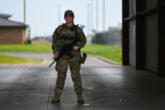September 17, 2021
Closing the Gaps Between Servicemembers and the American Public
We have been a nation at war — sort of. Due to the longest wars in American history being shouldered by a tiny percentage of the population, the vital civil-military relationship has become strained since 9/11.
Following the 9/11 attacks, military enlistments increased only marginally during the remainder of 2001, and stabilized after a few months. At the time, the military services reported a temporary spike in enlistment inquiries, yet few followed through. Recent events, such as a large military presence monitoring the June 2020 protests across the country, politicization of the armed forces leading up to the 2020 presidential election, and the response of the Department of Defense during the Jan. 6 attack on the US Capitol, indicate that there is a civil-military disconnect at the highest levels. Yet, there is a deeper divide, between the military and the American public, indicating a breakdown between us and those who serve us. Two groups serve as good examples of this breakdown: veterans and military families.
For military families, the civil-military relationship since 9/11 has split them between two worlds.
Post-9/11 veterans have some significant differences compared to previous generations of veterans. Those who served in these past 20 years are more likely than the general veteran population to have been deployed, seen combat, and experienced emotional trauma. In addition to their in-service experiences, the transition back to civilian life is more isolated than the experience of pre-9/11 veterans, as few in their communities and workplaces share in the experience of military service. A common complaint from veterans seeking civilian employment is an employer market unfamiliar with the military experience, a societal change from previous generations of veterans. A follow-on effect to the isolation of the military experience in the US has been the perception of the general public by veterans, who consider themselves to be more patriotic than other Americans.
Read the full article and more from Inkstick.
More from CNAS
-
Pete Hegseth’s Views About Women and Military Standards
In recent weeks, Hegseth walked back comments made while promoting his book, where he said women did not belong in ground combat units. Without citing specific examples, he co...
By Katherine L. Kuzminski
-
Sharper: Trump's First 100 Days
Donald Trump takes office in a complex and volatile global environment. Rising tensions with China, the continued war in Ukraine, and instability in the Middle East all pose s...
By Charles Horn
-
Tackle the Military Recruiting Crisis
The Trump administration should drive a whole-of-government approach to address the military recruiting crisis and ensure that the nation has the quality force necessary to de...
By Katherine L. Kuzminski
-
What Trump’s Pick for Secretary of Defense Could Mean for Inclusivity in the Military
Dr. Kyleanne Hunter, Adjunct Senior Fellow with the Military, Veterans, and Society Program at CNAS joins to discuss the Trump administration nominee for secretary of defense....
By Dr. Kyleanne Hunter




